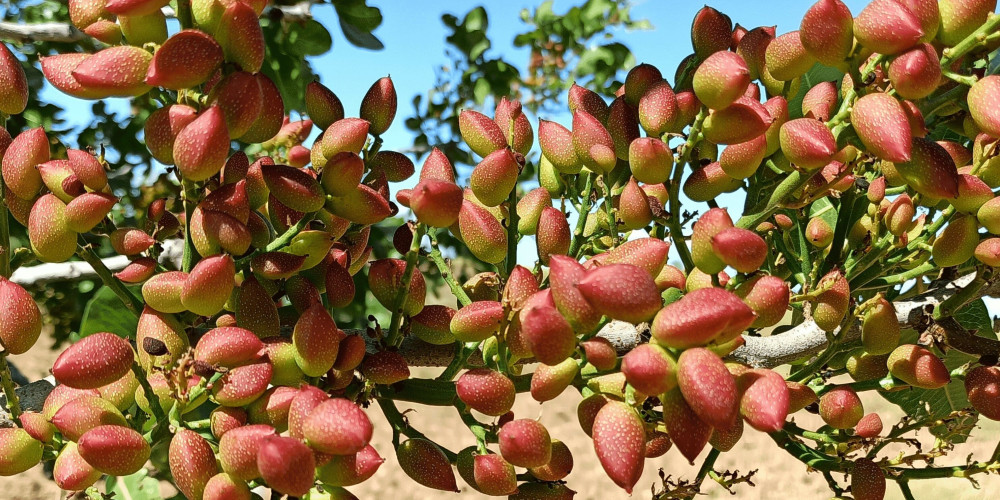Equilibrium®: use of biostimulation to mitigate alternate bearing in pistachio trees
Tuesday, 04 July 2023
Field Experience | Equilibrium®
Authors: Mauro Bernal, Juan Bueno, and Anna Botta. Bioiberica - Plant Health.
One of the problems with pistachio trees, as with other crops, is the high level of alternate bearing in production, being greater in non-irrigated land or plots where the availability of water and nutrients is low. Equilibrium® biostimulant is used in other crops to ensure bud retention and fruit set. This study tested the effect of Equilibrium® leaf treatments on reducing bud drop in annual growths when they compete with the fruit clusters. The results after 2 years of using Equilibrium® show significant increases in the percentage of viable buds, as well as in the productive and quality parameters in those pistachio trees treated with the biostimulant, ensuring the present and future profitability of this crop.
Present and Future of Pistachio Cultivation
Pistachio cultivation is growing both nationally and internationally. In Spain, the cultivated area has grown by 11% in 2022 compared to the previous year, reaching 66,467 ha (data from the CAP and the Regepa farm registry). This increase is mainly due to two factors: climatic adaptability and the good prices farmers receive because of rising consumer demand, both in the domestic and international markets. These two factors mainly drive the development of other sectors such as plant production, variety research, and industrial development, among others.
However, the problem with pistachio trees is that it is a crop that has a high level of alternate bearing or fluctuation from one year to the next. This instability in crop yield is mostly a genetic feature, but as with all fruit trees, this alternate bearing can be reduced to a greater or lesser extent using agricultural practices such as irrigation, fertilization and pruning. Specifically, for pistachio trees, one of the most important factors is the interference between fruit growth and vegetative growth (competition in the development of both organs). This competition triggers a situation where cluster development in the second year competes with annual vegetative growth by reducing its length, even aborting buds that would be productive the following year.
The aim of this article is to reveal a new tool in pistachio production based on biostimulation (Equilibrium®) for the retention of buds in annual growth shoots, thus reducing this alternate bearing. The study results obtained in 2022 after two years of treatment (2021 and 2022) on Pistacia vera L Var. Kerman crops using Bioiberica’s Equilibrium® product, a biostimulant with a synergistic action comprised of a matrix of free L-α-amino acids and Ascophyllum nodosum extract, which stimulates fruit retention and fruit set.
Description of the Study
In this trial, the effect of leaf applications of Equilibrium® throughout the year on pistachio crops was studied to assess mitigation of alternate bearing on the crop harvest. The effects produced by Equilibrium® were compared with trees that did not receive this treatment but were maintained in the same way. The trial took place at a 20-year-old, Kerman variety pistachio tree estate, located in Herencia (Ciudad Real). The trees were arranged in a 7 m x 7 m planting frame. For the Equilibrium® treatment, 5 leaf applications of the biostimulant were made using 3 litres per hectare, with a liquid volume of 2000 L/ha. To study the biostimulant effect the following were assessed: the number of buds that were retained during the vegetative growth for the year, qualitative parameters such as the percentage of pistachio nuts open/closed, empty/full, and grain yield. The 2022 assessments after 2 years of treatment were carried out by segmenting the plot into 6 blocks where 300 shoots per study thesis were selected for the study.
Mitigating effects on alternate bearing and crop harvest
To assess the efficacy of Equilibrium® on bud retention and to ensure more fruit clusters the following year, the number of viable buds per shoot was assessed in relation to the total number of buds. The results showed a significant increase of 20% in viable buds on those pistachio trees treated with Equilibrium® (Graph 1) in relation to the untreated control.
Graph 1. Viable buds and total buds in untreated (Control) and Equilibrium® treated pistachio trees. The photo shows the detail of an aborted bud scar and a viable bud. *Statistically significant differences (LSD, P = 0.05).
At harvest, the productive and qualitative parameters that add value to the fruit were assessed. In terms of production, pistachio nut yield showed a significant and relevant increase of 65.8% on those plots treated with Equilibrium® compared to the Control (Graph 2).
Graph 2. Nut yield at harvest from untreated (Control) and Equilibrium®-treated pistachio trees in the sampling assessment *Statistically significant differences (LSD, P = 0.05)
Pistachio quality parameters were also assessed at the time of harvesting. The results showed significant differences in the percentage of full pistachios compared to empty pistachios and in comparison to those trees treated with Equilibrium® to those not treated, with an increase of 8.5%. There was also a substantial increase (+16.7%) of open pistachios compared to closed pistachios treated with the biostimulant (Graph 3).
Graph 3. Percentage of full pistachios compared to empty pistachios and percentage of open pistachios compared to closed pistachios at harvest in untreated (Control) and Equilibrium®-treated pistachio trees *Statistically significant differences (LSD, P = 0.05)
Conclusion
The high present and future profitability of pistachio cultivation depends in part on mitigating the alternate bearing nature of the crop. Equilibrium®, in addition to improving yield and quality parameters, is a useful tool in ensuring the following year’s harvest and therefore reducing crop fluctuations as a result of alternate bearing, as has been seen by increasing the number of buds per shoot.





